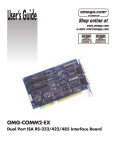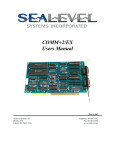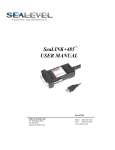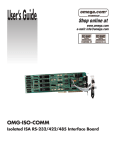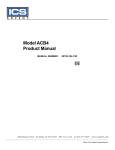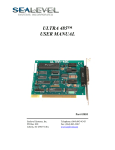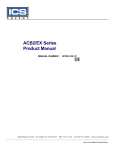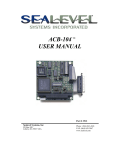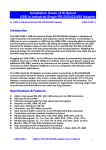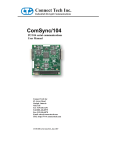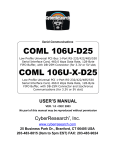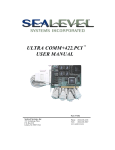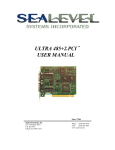Download OMG-SIO-530 operator`s manual
Transcript
Contents INTRODUCTION ..................................................................... 1 OVERVIEW .................................................................................. 1 WHAT’S INCLUDED ..................................................................... 1 FACTORY DEFAULT SETTINGS ..................................................... 1 CARD SETUP ......................................................................... 2 PORT ENABLE / DISABLE ............................................................. 3 IRQ SELECTION .......................................................................... 3 INTERFACE SELECTION ................................................................ 4 E2 JUMPER SETTINGS .................................................................. 4 E1 Jumper setting for RS-232.................................................. 5 E1 Jumper setting for RS-530 and RS-422 .............................. 6 E1 Jumper setting for RS-485.................................................. 7 E1 Jumper setting for 20 mA Current Loop............................. 8 INSTALLATION ...................................................................... 9 TECHNICAL DESCRIPTION .................................................. 10 CONNECTOR PIN ASSIGNMENTS ................................................. 11 RS-232.................................................................................. 11 RS-530/422/485 .................................................................... 11 RS-530/422/485 Line Termination ........................................ 11 20 mA Current Loop ............................................................. 12 CURRENT LOOP CONNECTIONS .................................................. 12 Passive Connection ............................................................... 12 Active Connection................................................................. 12 SPECIFICATIONS ................................................................. 13 ENVIRONMENTAL SPECIFICATIONS ............................................. 13 MANUFACTURING ..................................................................... 13 POWER CONSUMPTION .............................................................. 13 MEAN TIME BETWEEN FAILURES (MTBF).................................. 13 PHYSICAL DIMENSIONS ............................................................. 13 APPENDIX A - TROUBLESHOOTING .................................... 14 APPENDIX B - HOW TO GET ASSISTANCE .......................... 16 APPENDIX C - ELECTRICAL INTERFACE ............................ 17 RS-232..................................................................................... 17 RS-422..................................................................................... 17 RS-530..................................................................................... 18 RS-485..................................................................................... 18 20 MA CURRENT LOOP ............................................................. 19 APPENDIX D - ASYNCHRONOUS COMMUNICATIONS .......... 20 APPENDIX E - SILK-SCREEN............................................... 21 APPENDIX F - SCHEMATIC ................................................. 22 APPENDIX G - COMPLIANCE NOTICES ............................... 23 COMPLIANCE NOTICES ......ERROR! BOOKMARK NOT DEFINED. FEDERAL COMMUNICATIONS COMMISSION STATEMENT .............. 23 EMC DIRECTIVE STATEMENT.................................................... 23 WARRANTY ......................................................................... 24 Figures Figure 1 - Address Selection Table........................................................2 Figure 2 - DIP-Switch Illustration .........................................................2 Figure 3 - Header E2 and E3, IRQ Selection........................................3 Figure 4 - Header E2 options.................................................................4 Figure 5 - Header E1 RS-232 Interface Selected ..................................5 Figure 6 - Header E1 RS-530/422 Interface Selected ...........................6 Figure 7 - Header E1 RS-485 Interface Selected ..................................7 Figure 8 - Header E1 20 mA Current Loop Interface Selected............8 Figure 9 - Asynchronous Communications Bit Diagram .................... 20 © 1996j Omega Engineering, Incorporated. All rights reserved. Introduction Introduction Overview The OMG-SIO-530 provides the PC with one asynchronous serial port which can interface to RS-232, RS-422, RS-485, and 20 mA Current Loop devices. What’s Included The OMG-SIO-530 is shipped with the following items. If any of these items are missing or damaged, contact the supplier. • • • OMG-SIO-530 Serial I/O Adapter 3.5” Serial Utility Diskette User Manual Factory Default Settings The OMG-SIO-530 factory default settings are as follows: Base Address 3F8 IRQ 4 Electrical Specification RS-232 To install the OMG-SIO-530 using factory default settings, refer to Installation on page 9. For your reference, record installed OMG-SIO-530 settings below: Base Address IRQ Omega Engineering OMG-SIO-530 Electrical Specification Page 1 Card Setup Card Setup The OMG-SIO-530 contains several jumper straps which must be set for proper operation. The OMG-SIO-530 occupies 8 consecutive I/O locations. A DIP-switch is used to set the base address for these locations. Be careful when selecting the base address as some selections conflict with existing ports. The following table shows several examples that typically do not cause a conflict. SW1 sets the I/O address for the OMG-SIO-530. Address Hex 280-287 2A0-2A7 2E8-2EF 2F8-2FF 3E8-3EF 300-307 328-32F 3F8-3FF Binary A9 A0 1010000XXX 1010100XXX 1011101XXX 1011111XXX 1111101XXX 1100000XXX 1100101XXX 1111111XXX 1 Off Off Off Off Off Off Off Off Switch Position Setting 2 3 4 5 6 On Off On On On On Off On Off On On Off Off Off On On Off Off Off Off Off Off Off Off On Off On On On On Off On On Off On Off Off Off Off Off 7 On On Off Off Off On Off Off Figure 1 - Address Selection Table The following illustration shows the correlation between the DIP-switch setting and the address bits used to determine the base address. In the example below, address 300 is selected as a base. Address 300 in binary is XX11 0000 0XXX where X = a non-selectable address bit. A9 A3 EN ON 1 2 3 4 5 6 7 8 Figure 2 - DIP-Switch Illustration Note: Setting the switch “On” or “Closed” corresponds to a “0” in the address, while leaving it “Off” or “Open” corresponds to a “1”. Refer to Appendix A for common address contentions. Omega Engineering OMG-SIO-530 Page 2 Card Setup Port Enable / Disable Each port on the OMG-SIO-530 can be enabled or disabled with switch position 8 on the DIP-switch. The port is enabled with the switch “On” or “Closed” and disabled when “Off” or “Open”. If any port is disabled, be sure to disable the interrupt request for that port by removing the IRQ jumper. IRQ Selection Header E3 selects the interrupt request for the serial port. If COM1: is selected, this jumper must be on the IRQ4 setting. If COM2: is selected, this jumper must be on IRQ3. Consult your particular software for IRQ selection. If no interrupt is desired, remove the jumper. E3 MN75432 Figure 3 - Header E2 and E3, IRQ Selection Position “M” & “N” allow the user to select a single interrupt per port mode or a shared interrupt mode. The “N” selects the single interrupt per port mode, which is the typical DOS, OS/2 and Windows 3.1 mode of operation. The “M” selects the shared interrupt mode, which allows more than one port to access a single IRQ, and indicates the inclusion of a 1K ohm pull-down resistor required on one port when sharing interrupts. This mode is used by software that requires COM3: and COM4: to share interrupts with COM1: and COM2: or in an OEM configuration to support a specific software application. Note: Most communications software applications default COM3: to IRQ4 and COM4: to IRQ3. This requires the sharing of interrupts between COM1: and COM3:, and between COM2: and COM4:. While this is the default, it is not always the preferred setting. Check your software configuration instructions to determine the most appropriate IRQ selection. Note: The actual Silk-Screen for the OMG-SIO-530 may have a “2” in place of the IRQ “2/9” selection. Omega Engineering OMG-SIO-530 Page 3 Card Setup Interface Selection Headers E1 and E2 connect the DB-25 connector (P1) to either RS-232 interface drivers / receivers, RS-422/485 interface drivers / receivers or to the Current Loop receiver interface. Note: On E2 you must move all eight push-on jumpers. This is required to completely isolate RS-232 signals from RS-422/485 and viceversa. On E1, however, there are several jumper options. E2 jumper settings E2 RS-232 E2 RS-530/422/485 E2 20 mA Current Loop Figure 4 - Header E2 options Omega Engineering OMG-SIO-530 Page 4 Card Setup E1 Jumper setting for RS-232 E1 GND EN CL RI DCD DSR CTS RD B A Figure 5 - Header E1 RS-232 Interface Selected GND EN CL RI DCD DSR CTS RD Ground “A” selects normal ground for RS-232. Enable “A” (Not Applicable to RS-232). Current Loop “A” selects RS-232 Receive Data. Ring Indicator “A” enables RI, “B” sets it true. Data Carrier Detect “A” selects RS-232. Data Set Ready “A” selects RS-232. Clear To Send “A” selects RS-232. Receive Data “A” selects RS-232. Omega Engineering OMG-SIO-530 Page 5 Card Setup E1 Jumper setting for RS-530 and RS-422 E1 GND EN CL RI DCD DSR CTS RD B A Figure 6 - Header E1 RS-530/422 Interface Selected GND EN CL RI DCD DSR CTS RD Ground “B” selects 100 Ohm ground for RS-530/422. Enable “A” position for RS-530. Current Loop “A” selects RS-530 Receive Data. Ring Indicator (not used on RS-530) “B” sets it true. Data Carrier Detect “B” selects RS-530. Data Set Ready “B” selects RS-530. Clear To Send “B” selects RS-530. Receive Data “B” selects RS-530. Omega Engineering OMG-SIO-530 Page 6 Card Setup E1 Jumper setting for RS-485 E1 GND EN CL RI DCD DSR CTS RD B A Figure 7 - Header E1 RS-485 Interface Selected GND EN CL RI DCD DSR CTS RD Ground “B” selects 100 Ohm ground for RS-485. Enable driver with RTS “B” .”A” is always enabled. Current Loop “A” selects RS-485 Receive Data. Ring Indicator not used on RS-485 “B” sets it true. Data Carrier Detect “B” selects RS-485. Data Set Ready “B” selects RS-485. Clear To Send “B” selects RS-485. Receive Data “B” selects RS-485. E1 position “EN” is used to enable the driver with RTS. To permanently enable the driver (normal RS-422 point to point mode) remove jumper “EN” at E1. Failure to correctly set this jumper can cause transmitter contention problems, preventing operation by any nodes on the network. E1 position “GND” determines whether the board provides a direct ground connection (as in RS-232 and most RS-422), or a 100 Ohm high impedance ground. The 100 Ohm high impedance ground is normally used in RS-485 (and some RS-422) to avoid ground loop currents with long cables. Omega Engineering OMG-SIO-530 Page 7 Card Setup E1 Jumper setting for 20 mA Current Loop E1 GND EN CL RI DCD DSR CTS RD B A Figure 8 - Header E1 20 mA Current Loop Interface Selected GND EN CL RI CD DSR CTS RD Ground “A” selects normal ground for Current Loop. N/A Current Loop “B” selects Current Loop receive data. Ring Indicator not used, “B” sets it true. N/A N/A N/A Receive Data - Remove or “Float” on one pin for Current Loop. Omega Engineering OMG-SIO-530 Page 8 Installation Installation The OMG-SIO-530 can be installed in any of the PC expansion slots, but to access the “AT” or (E)ISA IRQ’s (10, 11, 12, 15) it must be installed in one of the 16 bit slots. The OMG-SIO-530 contains several jumper straps for each port which must be set for proper operation prior to installing the adapter into the computer. 1. 2. 3. 4. 5. 6. 7. Turn off PC power. Disconnect the power cord. Remove the PC case cover. Locate an available slot and remove the blank metal slot cover. Gently insert the OMG-SIO-530 into the slot. Make sure that the adapter is seated properly. Replace the screw. Replace the cover. Connect the power cord. Installation is complete. Omega Engineering OMG-SIO-530 Page 9 Technical Description Technical Description The OMG-SIO-530 provides one async serial port which can interface to RS-232, RS-530, RS-422, RS-485, and 20 mA Current Loop. Features include: • DB-25 male connector mounted on board bracket. Port can be addressed as COM1:- 4, or any other I/O address up to 3FF Hex. • Interrupt Request (IRQ) lines are jumper selected for IRQ 3,4,5 and 2/9. • RS-232C Interface with all standard PC signals (TD, RD, RTS, CTS, DSR, DCD, DTR, RI) or RS-530/422 interface . • Serial port interface (RS-232, RS-530/422/485, 20 mA Current Loop) is determined by jumper selection. The OMG-SIO-530 is designed for asynchronous only operation and therefore implements only those signals associated with async operation. The DTE mode for RS-530 is assumed. The OMG-SIO-530 utilizes the 16550 UART chip. This chip features programmable baud rate, data format, interrupt control and has a 16 byte transmit and receive FIFO. The OMG-SIO-530 can be addressed as COM1:, COM2:, or any other I/O address up to 3FF Hex, providing total compatibility with most communications software and languages. RS-232, RS-530/422/485, and 20 mA Current Loop compatible drivers and receivers are provided on the serial port. Omega Engineering OMG-SIO-530 Page 10 Technical Description Connector Pin Assignments RS-232 Signal GND RD CTS DSR DCD RI DTR TD RTS Name Ground Receive Data Clear To Send Data Set Ready Data Carrier Detect Ring Indicator Data Terminal Ready Transmit Data Request To Send Pin # 7 3 5 6 8 22 20 2 4 Mode Input Input Input Input Input Output Output Output RS-530/422/485 Signal GND RDB RDA CTSB CTSA DSRB DSRA DCDB DCDA TDB TDA RTSB RTSA DTRB DTRA RX+ RXCTS+ CTSDSR+ DSRDCD+ DCD TX+ TXRTS+ RTSDTR+ DTR- Name Ground Receive Positive Receive Negative Clear To Send Positive Clear To Send Negative Data Set Ready Positive Data Set Ready Negative Data Carrier Detect Positive Data Carrier Detect Negative Transmit Positive Transmit Negative Request To Send Positive Request To Send Negative Data Terminal. Ready Positive Data Terminal Ready Negative Pin # 7 16 3 13 5 22 6 10 8 14 2 19 4 23 20 Mode Input Input Input Input Input Input Input Input Output Output Output Output Output Output RS-530/422/485 Line Termination Typically, each end of the RS-530/422/485 bus must have line terminating resistors. A 100 ohm resistor is across each RS-530/422/485 input in addition to a 1K ohm pull-up/pull-down combination that bias the receiver inputs. Omega Engineering OMG-SIO-530 Page 11 Technical Description 20 mA Current Loop Signal TD+ RD+ TDRD- Name Current Source #1 Transmit Data Positive Receive Data Positive Current Source #2 Transmit Data Negative Receive Data Negative Ground Pin # 21 25 12 9 24 11 7 To perform a loop-back test, connect pins 21 to 25, 24 to 12, and 11 to 7. Current Loop Connections Passive Connection Loop Input: Pin 12 (RD+) to Customer Current Source Pin 11 (RD-) to Customer TD+ output Loop Output: Pin 25 (TD+) to Customer Current Source Pin 24 (TD-) to Customer RD+ Input Active Connection Loop Input: Pin 21 (Current Source 1) to Pin 12 (RD+) Pin 11 (RD-) to Customer TD+ From Customer TD- to Pin 7 (Ground ) Loop Output: Pin 9 (Current Source 2) to Pin 25 (TD+) Pin 24 (TD-) to Customer RD+ From Customer RD- to Pin 7 (Ground ) Omega Engineering OMG-SIO-530 Page 12 Specifications Specifications Environmental Specifications Specification Temperature Range Humidity Range Operating 0º to 50º C (32º to 122º F ) 10 to 90% R.H. Non-Condensing Storage -20º to 70º C (-4º to 158º F) 10 to 90% R.H. Non-Condensing Manufacturing • IPC 610-A Class-III standards are adhered to with a 0.1 visual A.Q.L. and 100% Functional Testing. • All Omega Engineering Printed Circuit boards are built to U.L. 94V0 rating and are 100% electrically tested. These printed circuit boards are solder mask over bare copper or solder mask over tin nickel. Power Consumption Supply line Rating +12 VDC 50 mA -12 VDC 50 mA +5 VDC 195 mA Mean Time Between Failures (MTBF) Greater than 150,000 hours. (Calculated) Physical Dimensions Board length Board Height including Goldfingers Board Height excluding Goldfingers Omega Engineering OMG-SIO-530 4.9 inches 4.2 inches 3.9 inches (12.446 cm) (10.66 cm) (9.91 cm) Page 13 Appendix A - Troubleshooting Appendix A - Troubleshooting A Serial Utility Diskette is supplied with the Omega Engineering adapter and will be used in the troubleshooting procedures. By using this diskette and following these simple steps, most common problems can be eliminated without the need to call Technical Support. 1. Identify all I/O adapters currently installed in your system. This includes your on-board serial ports, controller cards, sound cards etc. The I/O addresses used by these adapters, as well as the IRQ (if any) should be identified. 2. Configure your Omega Engineering adapter so that there is no conflict with currently installed adapters. No two adapters can occupy the same I/O address. 3. Make sure the Omega Engineering adapter is using a unique IRQ. While the Omega Engineering adapter does allow the sharing of IRQ’s, many other adapters (i.e. SCSI adapters & on-board serial ports) do not. The IRQ is typically selected via an on-board header block. Refer to the section on Card Setup for help in choosing an I/O address and IRQ. 4. Make sure the Omega Engineering adapter is securely installed in a motherboard slot. 5. Use the supplied diskette and User Manual to verify that the Omega Engineering adapter is configured correctly. The supplied diskette contains a diagnostic program “SSD” that will verify if an adapter is configured properly. This diagnostic program is written with the user in mind and is easy to use. Refer to the “README” file on the supplied diskette for detailed instructions on using “SSD”. Omega Engineering OMG-SIO-530 Page 14 Appendix A - Troubleshooting 6. The following are known I/O conflicts: • • • • • • The 278 and 378 settings may conflict with your printer I/O adapter. 3B0 cannot be used if a Monochrome adapter is installed. 3F8-3FF is typically reserved for COM1: 2F8-2FF is typically reserved for COM2: 3E8-3EF is typically reserved for COM3: 2E8-2EF is typically reserved for COM4: 7. Please refer to your included diskette for any post production manual updates and application specific information. 8. Always use the Omega Engineering diagnostic software when Troubleshooting a problem. This will eliminate the software issue from the equation. Omega Engineering OMG-SIO-530 Page 15 Appendix B - How To Get Assistance Appendix B - How To Get Assistance Please refer to Appendix A - Troubleshooting prior to calling Technical Support. 1. Read this manual thoroughly before attempting to install the adapter in your system. 2. When calling for technical assistance, please have your user manual and current adapter settings. If possible, please have the adapter installed in a computer ready to run diagnostics. 3. Omega Engineering maintains a Web site at WWW.OMEGA.COM where the latest manuals and software revisions may be found 4. Technical support is available Monday to Friday from 8:30 a.m. to 6:00 p.m. Eastern time. Technical support can be reached at (800)826-6342 x2295. RETURN AUTHORIZATION MUST BE OBTAINED FROM OMEGA ENGINEERING BEFORE RETURNED MERCHANDISE WILL BE ACCEPTED. AUTHORIZATION CAN BE OBTAINED BY CALLING OMEGA ENGINEERING AND REQUESTING A RETURN MERCHANDISE AUTHORIZATION (RMA) NUMBER. Omega Engineering OMG-SIO-530 Page 16 Appendix C - Electrical Interface Appendix C - Electrical Interface RS-232 Quite possibly the most widely used communication standard is RS-232. This implementation has been defined and revised several times and is often referred to as RS-232 or EIA/TIA-232. It is defined by the EIA as the Interface between Data Terminal Equipment and Data CircuitTerminating Equipment Employing Serial Binary Data Interchange. The mechanical implementation of RS-232 is on a 25 pin D sub connector. RS-232 is capable of operating at data rates up to 20 Kbps at distances less than 50 ft. The absolute maximum data rate may vary due to line conditions and cable lengths. RS-232 often operates at 38.4 Kbps over very short distances. The voltage levels defined by RS-232 range from -12 to +12 volts. RS-232 is a single ended or unbalanced interface, meaning that a single electrical signal is compared to a common signal (ground) to determine binary logic states. A voltage of +12 volts (usually +3 to +10 volts) represents a binary 0 (space) and -12 volts (-3 to -10 volts) denotes a binary 1 (mark). The RS-232 and the EIA/TIA-574 specification defines two type of interface circuits, Data Terminal Equipment (DTE) and Data Circuit-terminating Equipment (DCE). The Omega Engineering adapter is a DTE interface. RS-422 The RS-422 specification defines the electrical characteristics of balanced voltage digital interface circuits. RS-422 is a differential interface that defines voltage levels and driver/receiver electrical specifications. On a differential interface, logic levels are defined by the difference in voltage between a pair of outputs or inputs. In contrast, a single ended interface, for example RS-232, defines the logic levels as the difference in voltage between a single signal and a common ground connection. Differential interfaces are typically more immune to noise or voltage spikes that may occur on the communication lines. Differential interfaces also have greater drive capabilities that allow for longer cable lengths. RS-422 is rated up to 10 Megabits per second and can have cabling 4000 feet long. RS-422 also defines driver and receiver electrical characteristics that will allow 1 driver and up to 32 receivers on the line at once. RS-422 signal levels range from 0 to +5 volts. RS-422 does not define a physical connector. Omega Engineering OMG-SIO-530 Page 17 Appendix C - Electrical Interface RS-530 RS-530 (a.k.a. EIA-530) compatibility means that RS-422 signal levels are met, and the pin-out for the DB-25 connector is specified. The EIA (Electronic Industry Association) created the RS-530 specification to detail the pin-out, and define a full set of modem control signals that can be used for regulating flow control and line status. The RS-530 specification defines two types of interface circuits, Data Terminal Equipment (DTE) and Data Circuit-Terminating Equipment (DCE). The Omega Engineering adapter is a DTE interface. RS-485 RS-485 is backwardly compatible with RS-422; however, it is optimized for partyline or multi-drop applications. The output of the RS-422/485 driver is capable of being Active (enabled) or Tri-State (disabled). This capability allows multiple ports to be connected in a multi-drop bus and selectively polled. RS-485 allows cable lengths up to 4000 feet and data rates up to 10 Megabits per second. The signal levels for RS-485 are the same as those defined by RS-422. RS-485 has electrical characteristics that allow for 32 drivers and 32 receivers to be connected to one line. This interface is ideal for multi-drop or network environments. RS-485 tri-state driver (not dual-state) will allow the electrical presence of the driver to be removed from the line. The driver is in a tri-state or high impedance condition when this occurs. Only one driver may be active at a time and the other driver(s) must be tri-stated. The output modem control signal Request To Send (RTS) controls the state of the driver. Some communication software packages refer to RS-485 as RTS enable or RTS block mode transfer. RS-485 can be cabled in two ways, two wire and four wire mode. Two wire mode does not allow for full duplex communication, and requires that data be transferred in only one direction at a time. For half-duplex operation, the two transmit pins should be connected to the two receive pins (Tx+ to Rx+ and Tx- to Rx-). Four wire mode allows full duplex data transfers. RS-485 does not define a connector pin-out or a set of modem control signals. RS-485 does not define a physical connector. Omega Engineering OMG-SIO-530 Page 18 Appendix C - Electrical Interface 20 mA Current Loop This communication specification is based on the presence or absence of current, not voltage levels, over the communication lines. The logic of a Current Loop communications circuit is determined by the presence or absence of current (typically + or - 20 mA). When referring to the specification, the current value is usually states (i.e. 20 mA Current Loop). Current Loop is used for point to point communication and there are typically two current sources, one for transmit and one for receive. These two current sources may be located at either end of the communication line. To ensure a proper current path to ground, or loop, the cabling of two current loop communication ports will depend on the location of the current sources. Current Loop is normally good for data rates up to 19.2 Kbps. This limitation is due to the fact that the drivers and receivers are usually optically isolated circuits that are inherently slower than non-isolated equivalent circuits. Omega Engineering OMG-SIO-530 Page 19 Appendix D - Asynchronous Communications Appendix D - Asynchronous Communications Serial data communications implies that individual bits of a character are transmitted consecutively to a receiver that assembles the bits back into a character. Data rate, error checking, handshaking, and character framing (start/stop bits) are pre-defined and must correspond at both the transmitting and receiving ends. Asynchronous communications is the standard means of serial data communication for PC compatibles and PS/2 computers. The original PC was equipped with a communication or COM: port that was designed around an 8250 Universal Asynchronous Receiver Transmitter (UART). This device allows asynchronous serial data to be transferred through a simple and straightforward programming interface. Character boundaries for asynchronous communications are defined by a starting bit followed by a pre-defined number of data bits (5, 6, 7, or 8). The end of the character is defined by the transmission of a pre-defined number of stop bits (usual 1, 1.5 or 2). An extra bit used for error detection is often appended before the stop bits. Idle state of line Odd, Even 5 to 8 Data Bits or Unused Remain Idle or next start bit 1 P BIT STOP 0 1 1.5 2 Figure 9 - Asynchronous Communications Bit Diagram This special bit is called the parity bit. Parity is a simple method of determining if a data bit has been lost or corrupted during transmission. There are several methods for implementing a parity check to guard against data corruption. Common methods are called (E)ven Parity or (O)dd Parity. Sometimes parity is not used to detect errors on the data stream. This is refereed to as (N)o parity. Because each bit in asynchronous communications is sent consecutively, it is easy to generalize asynchronous communications by stating that each character is wrapped (framed) by pre-defined bits to mark the beginning and end of the serial transmission of the character. The data rate and communication parameters for asynchronous communications have to be the same at both the transmitting and receiving ends. The communication parameters are baud rate, parity, number of data bits per character, and stop bits (i.e. 9600,N,8,1). Omega Engineering OMG-SIO-530 Page 20 Appendix E - Silk-Screen Appendix E - Silk-Screen 4.2" 4.9" 3.9" Omega Engineering OMG-SIO-530 Page 21 Appendix F - Schematic Appendix F - Schematic Omega Engineering OMG-SIO-530 Page 22 Appendix G - Compliance Notices Appendix G - Compliance Notices Federal Communications Commission Statement FCC - This equipment has been tested and found to comply with the limits for Class A digital device, pursuant to Part 15 of the FCC Rules. These limits are designed to provide reasonable protection against harmful interference when the equipment is operated in a commercial environment. This equipment generates, uses, and can radiate radio frequency energy and, if not installed and used in accordance with the instruction manual, may cause harmful interference to radio communications. Operation of this equipment in a residential area is likely to cause harmful interference in such case the user will be required to correct the interference at his own expense. EMC Directive Statement Products bearing the CE Label fulfill the requirements of the EMC directive (89/336/EWG) and of the lowvoltage directive (73/23/EWG) issued by the European Commission. To obey these directives, the following European standards must be met: • EN55022 Class A - “Limits and methods of measurement of radio interference characteristics of information technology equipment” • EN50082-1 - “Electromagnetic compatibility - Generic immunity standard” • Part 1 : Residential, commercial and light industry • EN60950 (IEC950) - “Safety of information technology equipment, including electrical business equipment” Warning This is a Class A Product. In a domestic environment this product may cause radio interference in which case the user may be required to take adequate measures. Always use cabling provided with this product if possible. If no cable is provided or if an alternate cable is required, use high quality shielded cabling to maintain compliance with FCC/EMC directives. Omega Engineering OMG-SIO-530 Page 23 Warranty Warranty Omega Engineering, Inc. warrants this product to be in good working order for a period of one year from the date of purchase. Should this product fail to be in good working order at any time during this period, Omega Engineering will, at it's option, replace or repair it at no additional charge except as set forth in the following terms. This warranty does not apply to products damaged by misuse, modifications, accident or disaster. Omega Engineering assumes no liability for any damages, lost profits, lost savings or any other incidental or consequential damage resulting from the use, misuse of, or inability to use this product. Omega Engineering will not be liable for any claim made by any other related party. RETURN AUTHORIZATION MUST BE OBTAINED FROM OMEGA ENGINEERING BEFORE RETURNED MERCHANDISE WILL BE ACCEPTED. AUTHORIZATION CAN BE OBTAINED BY CALLING OMEGA ENGINEERING AND REQUESTING A RETURN MERCHANDISE AUTHORIZATION (RMA) NUMBER. Omega Engineering, Incorporated PO Box 4047 One Omega Drive Stamford, CT 06907 (800)826-6342 FAX: (203)359-7990 email: Internet: [email protected] WWW Site: www.omega.com Technical Support is available from 8:30 a.m. to 6 p.m. Eastern time. Monday - Friday Trademarks Omega Engineering, Incorporated acknowledges that all trademarks referenced in this manual are the service mark, trademark, or registered trademark of the respective company. OMG-SIO-530 is a trademark of Omega Engineering, Incorporated. Omega Engineering OMG-SIO-530 Page 24


























